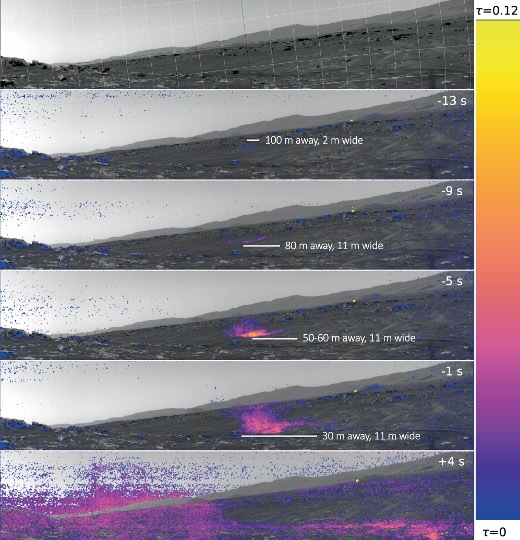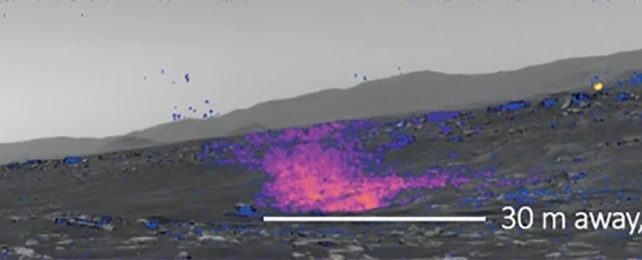The Martian soundscape can be as hauntingly alien as one might hope to hear on another world. The boom of occasional meteorite impacts, the groan of the quaking ground, the whisper of an endless wind.
Now we get a front-row seat at the approach and retreat of a roaring devil as it scours the surface, helping drive the cycle of dust through the atmosphere and around the small, rust-stained world.
Perseverance was the first rover to reach the surface of Mars with a working microphone attached, and the instrument has been put to good use since the rover landed in February 2021. The mic is part of a suite of recording tools on the rover known as the SuperCam.
It's thanks to this innovative piece of technology that we can hear for the first time what a miniature whirlwind of dust sounds like on another planet. It's eerie and brief and quite fantastic at the same time.
"We can learn a lot more using sound than we can with some of the other tools," says planetary scientist Roger Wiens from Purdue University in Indiana.
"They take readings at regular intervals."
"The microphone lets us sample, not quite at the speed of sound, but nearly 100,000 times a second. It helps us get a stronger sense of what Mars is like."
Perseverance's microphone actually only records for three minutes a day: this is the first time it's been on when a dust devil has wandered past, even though other instruments have recorded evidence of almost 100 other whirlwinds where the rover is based in the Jezero Crater.
The dust devil passed over the rover on 27 September 2021 – the 215th Martian day (or sol) of its mission. Scientists estimate that the size of the dust devil was around 25 meters (just over 80 feet) wide, while it would have been at least 118 meters (387 feet) tall.
By combining photographs with readings of wind, pressure, temperature, and dust, Perseverance was also able to track the speed of the mini-Martian tornado as it passed, which came in at 19 kilometers (12 miles) per hour.

"This chance dust devil encounter demonstrates the potential of acoustic data for resolving the rapid wind structure of the Martian atmosphere," Wiens and colleagues write in their paper.
The surrounding winds would've been faster, and in the recording, you can hear the silence that reflects the calm eye of this particular tiny storm. Part of what makes the new information valuable is how it compares to events like this on Earth.
"The wind is fast – about 25 miles per hour, but about what you would see in a dust devil on Earth," says Wiens. "The difference is that the air pressure on Mars is so much lower that the winds, while just as fast, push with about 1 percent of the pressure the same speed of wind would have back on Earth."
"It's not a powerful wind, but clearly enough to loft particles of grit into the air to make a dust devil."
All of the data that we're currently collecting on Mars is useful for a variety of reasons. For one, it gives us a better idea of how the planet evolved, which in turn gives scientists clues to how other planets in the Universe might be evolving too.
Those other planets include Earth, and as Mars is our closest planetary neighbor, our histories are closely intertwined. Comparing Earth and Mars gives us a better idea of the past and the future of both planets.
There's also humankind's ambition to one day set foot on Mars. Recordings like this hint at the sort of conditions we can expect, and how those conditions might be protected against or utilized – the way that wind might naturally clear solar panels, for example.
"Just like Earth, there is different weather in different areas on Mars," says Wiens. "Using all of our instruments and tools, especially the microphone, helps us get a concrete sense of what it would be like to be on Mars."
The research has been published in Nature Communications.
